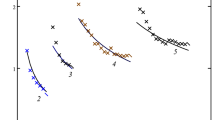Abstract
Formulae for hermitian operators representing covalent, ionic, and total bond indices are derived. The eigenstates of these operators come in pairs, and can be considered as bonding, anti-bonding and lone-pair orbitals. The form of these operators is derived by generalising the rule that the bond order be defined as the net number of bonding electron pairs. The percentage of covalency and ionicity of a chemical bond may be obtained, and bond indices can also be defined between groups of atoms. The calculation of the bond indices depends only on the electron density operator, and certain projection operators used to represent each atom in the molecule. Bond indices are presented for a series of first and second row hydrides and fluorides, hydrocarbons, a metal complex, a Diels–Alder reaction and a dissociative reaction. In general the agreement between the bond indices is in accord with chemical intuition. The bond indices are shown to be stable to basis set expansion.
Similar content being viewed by others
References
Pople JA (1999). Angew Chem 38: 1894
Pauling L (1960). The nature of the chemical bond, 3rd edn. Cornell University Press, New York
Roby KR (1973) In Chissick SS, Price WC, Ravensdale T (eds.) Wave mechanics—the first fifty years. Butterworths, London, pp 38–60
Roby KR (1974). Mol Phys 28: 1441
Roby KR (1974). Mol Phys 27: 81
Roby KR (1974). Theor Chem Acc 33: 105
Davidson ER (1967). J Chem Phys 46: 3320
Cruickshank DW and Avramides EJ (1982). Phil Trans R Soc Lond A 304: 533
Heinzmann R and Ahlrichs R (1976). Theor Chem Acc 42: 33
Ehrhardt C and Ahlrichs R (1985). Theor Chem Acc 68: 231
Su J, Li XW, Crittendon RC and Robinson GH (1997). J Am Chem Soc 119: 5471
Su J, Li XW, Crittendon RC, Campana CF and Robinson GH (1997). Organometallics 16: 4511
Dagani R (1998). Chem Eng News 76: 31
Nguyen T, Sutton AD, Brynda M, Fettinger JC, Long GJ and Power PP (2005). Science 310: 844
Frenking G (2005). Science 310: 796
Coppens P (1997) X-ray charge densities and chemical bonding. In: IUCr texts on crystallography vol. 4, 1st edn. Oxford University Press, Oxford
Jayatilaka D (1998). Phys Rev Lett 80: 798
Grimwood DJ and Jayatilaka D (2001). Acta Cryst A 57: 87
Savin A, Nesper R, Wengert S and Fassler TE (1997). Angew Chem 36: 1808
Silvi B and Savin A (1994). Nature 371: 683
Sannigrahi AB (1992). Adv Quantum Chem 23: 301
Coulson CA (1939). Proc R Soc (Lond) A 169: 413
Chirgwin BH and Coulson CA (1950). Proc R Soc (Lond) A 201: 196
McWeeny R (1951) J Chem Phys 19:164
McWeeny R (1960). J Chem Phys 20: 920
Mulliken RS (1955). J Chem Phys 23: 1833
Mulliken RS (1955). J Chem Phys 23: 1841
Wiberg K (1968) Tetrahedron Lett 24:1083
Mayer I (1983) Chem Phys Lett 97:270
Natiello MA, Medrano JA (1984) Chem Phys Lett 105:180
Ángyán JG, Rosta E, Surjan PR (1999) Chem Phys Lett 299:1
Reed AE, Curtiss LA, Weinhold F (1988) Chem Rev 88:899
Cioslowski J, Mixon ST (1991) J Am Chem Soc 113:4142
Cioslowski J, Mixon ST (1993) Inorg Chem 32:3209
Bader RFW (1990) Atoms in molecules: a quantum theory. Oxford University Press, New York
Ángyán JG, Loos M, Mayer I (1994) J Phys Chem 98:5244
Raub S, Jansen G (2001) Theor Chem Acc 106:223
Fulton RL (1993) J Phys Chem 97:7516
Fulton RL, Mixon ST (1993) J Phys Chem 97:7530
Yamasaki T, Mainz DT and Goddard WA (2000). J Phys Chem A 104: 2221
Löwdin PO (1998). Linear algebra for quantum theory. Wiley, New York
Araki H (1971). Publ RIMS Kyoto Univ 6: 385
Amos AT, Hall GG (1961) Proc R Soc (Lond) A263:483
Mayer I (1997). Int J Quantum Chem 63: 31
King HF, Stanton RE, Kim H, Wyatt RE and Parr RG (1967). J Chem Phys 47: 1936
Baushlicher CW and Taylor PR (1988). Theor Chem Acc 74: 63
Frisch MJ et al (1998) Gaussian 98. Technical report, Gaussian, Inc., Pittsburgh, PA
Dunning TH (1970). J Chem Phys 53: 2823
Dunning TH and Hay PJ (1977). In: Schaefer HF III (ed) Methods of electronic structure theory, vol 3. Plenum Press, New York
Schaftenaar G, Noordik JH (2000) J Comput-Aided Mol Design 14:123
Koutsantonis GA, Selegue JP (1991) J Am Chem Soc 113:2136
Merzbacher E (1998). Quantum mechanics 3rd edn. Wiley, New York
Author information
Authors and Affiliations
Rights and permissions
About this article
Cite this article
Gould, M.D., Taylor, C., Wolff, S.K. et al. A definition for the covalent and ionic bond index in a molecule. Theor Chem Account 119, 275–290 (2008). https://doi.org/10.1007/s00214-007-0282-x
Received:
Accepted:
Published:
Issue Date:
DOI: https://doi.org/10.1007/s00214-007-0282-x




